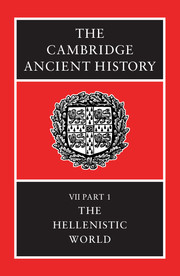Book contents
- Frontmatter
- 1 Sources for the period
- 2 The succession to Alexander
- 3 Monarchies and monarchic Ideas
- 4 The formation of the Hellenistic kingdoms
- 5 Ptolemaic Egypt
- 6 Syria and the East
- 7 Macedonia and Greece
- 8 Cultural, social and economic features of the Hellenistic world
- 9 Hellenistic science: its application in peace and war
- 10 Agathocles
- 11 The Syrian-Egyptian Wars and the new lingdoms of Asia Minor
- 12 Macedonia and the Greek leagues
- BIBLIOGRAPHY
- Index
- Map 3. Egypt.
- Map 4. Hellenistic Asia.
- Map 5. The Greek mainland and the Aegean.
- References
8 - Cultural, social and economic features of the Hellenistic world
Published online by Cambridge University Press: 28 March 2008
- Frontmatter
- 1 Sources for the period
- 2 The succession to Alexander
- 3 Monarchies and monarchic Ideas
- 4 The formation of the Hellenistic kingdoms
- 5 Ptolemaic Egypt
- 6 Syria and the East
- 7 Macedonia and Greece
- 8 Cultural, social and economic features of the Hellenistic world
- 9 Hellenistic science: its application in peace and war
- 10 Agathocles
- 11 The Syrian-Egyptian Wars and the new lingdoms of Asia Minor
- 12 Macedonia and the Greek leagues
- BIBLIOGRAPHY
- Index
- Map 3. Egypt.
- Map 4. Hellenistic Asia.
- Map 5. The Greek mainland and the Aegean.
- References
Summary
SOURCES AND APPROACHES
Four documents may serve as a framework for this chapter. The first is a much-discussed papyrus of the mid third century B.C., P. Lille 29, now generally agreed to be part of the municipal lawcode of Naucratis or Ptolemais. In the surviving fragment, §1 concerns the procedure to be followed if a slave is prosecuted ‘as if a free man’. If convicted his master may appeal, and if he loses the appeal, ‘execution of penalty is to be carried out according to the laws about slaves except insofar as the royal ordinance forbids’. §3 specifies that ‘slaves too may give evidence’, and that they may be tortured ‘unless (the judges) can judge from the pleadings deposited’. §4 lays down procedures when a master is or is not found responsible for a delict committed by his slave. In one eventuality the slave is to be whipped at least one hundred strokes, to be branded on the forehead ‘as the royal ordinances enjoin’, and to be sold abroad: though §2, in apparent contradiction, forbids the export, whipping, and branding of slaves (but a qualification may be lost in a lacuna). These laws, like those of Alexandria (P. Hal. 1), do not merely reveal once again how ‘there was no action or belief or institution in Graeco-Roman antiquity that was not one way or other affected by the possibility that someone involved might be a slave’. They also illustrate the complex relationship, attested in all the monarchies, between royal and civic law; the extent to which Greek-style slavery was taking root in Egypt, at least in the three poleis (less so, it appears, in the countryside (chora)); the debt which they owe, in dialect and content, to Athenian style; and the ambivalence, even clearer here than in classical Athenian law, between slave as object of rights and slave as intermittent subject of rights.
Keywords
- Type
- Chapter
- Information
- The Cambridge Ancient History , pp. 257 - 320Publisher: Cambridge University PressPrint publication year: 1984
References
- 15
- Cited by

